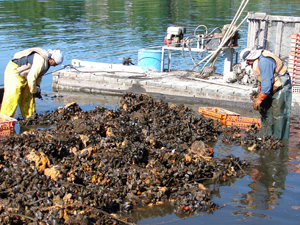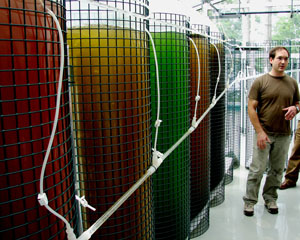Commerce, NOAA Release Draft National Aquaculture Policies, Invite Public Comment
February 9, 2011
Shellfish farming (oysters, clams, mussels) is the largest single sector of the U.S. marine aquaculture industry and accounts for about two-thirds of total U.S. marine aquaculture production. Pictured above, an oyster farm in the Damriscotta River in Maine.
High resolution (Credit: NOAA Aquaculture Program)
The Department of Commerce and National Oceanic and Atmospheric Administration (NOAA) today released complementary draft national aquaculture policies that support sustainable marine aquaculture to increase the U.S. supply of healthy seafood, create jobs in coastal and other communities, spur innovation in technology, and help restore depleted species and marine habitats. Marine aquaculture is the farming of marine organisms such as shellfish, finfish, and algae for food, habitat restoration, and rebuilding of wild fish stocks. The public is invited to comment on both draft policies for the next 60 days.
“Americans love seafood, and we consume approximately 5 billion pounds of it each year—a significant portion of which are imports. In fact, our current trade deficit is approximately $9 billion,” Commerce Secretary Gary Locke said. “Supporting the U.S. aquaculture industry will encourage economic growth and employment opportunities at home, support exports to global markets, and spur new innovations in technology to support the industry.”
Aquaculture is playing a significant and growing role in global food production. Already, nearly half the fish consumed by people is produced by aquaculture, and a significant portion of future increases in the global seafood supply will come from aquaculture. In the U.S., some 84 percent of the seafood Americans eat is imported, and about half of those imports are aquaculture products. The domestic aquaculture industry supplies only about 5 percent of the seafood Americans consume.
Mussels farmed in coastal areas and in the open ocean are one of the most promising sectors of the U.S. marine aquaculture industry. Pictured above, workers harvest a mussel raft in Shelton, Wash.
High resolution (Credit: NOAA Aquaculture Program)
Once in place, the aquaculture policies will benefit the industry by outlining how NOAA plans to fund research into innovative aquaculture technologies, work with partners to create job initiatives that encourage the growth of the industry, and grant access to favorable sites for aquaculture facilities.
In the last decade, American expertise and innovation played a significant role in the development of aquaculture in foreign countries. Once they are final, the Commerce and NOAA policies will promote a sustainable industry in the U.S., encouraging Americans to apply their ingenuity at home.
“If done wisely, aquaculture can complement wild fisheries while contributing to healthy oceans and coastal economies,” said Jane Lubchenco, Ph.D., under secretary of commerce for oceans and atmosphere and NOAA administrator. “As we rebuild wild fish populations, we recognize the world’s demand for safe, healthy seafood will continue to grow. Sustainable aquaculture increases our country’s food security.”
The draft Commerce Department policy supports the development of sustainable aquaculture within the context of the key Commerce goals of encouraging economic growth and employment opportunities in the United States.
The draft NOAA policy provides guidance for NOAA’s actions regarding the development of all forms of marine aquaculture, from shellfish farming and habitat restoration to the culture of marine fish and algae on land and offshore. The policy provides a national approach for supporting sustainable commercial production, expanding restoration aquaculture, and researching and developing new technologies, and is part of NOAA’s national approach to sustainable seafood, which encompasses both aquaculture and capture fisheries.
The Commerce and NOAA draft policies echo several priorities of President Obama’s National Ocean Policy, including the emphasis on protecting, maintaining and restoring healthy and diverse ecosystems; supporting sustainable uses of the ocean; and increasing scientific understanding and applying that knowledge to make better decisions.
The new draft NOAA Aquaculture Policy provides guidance for agency actions regarding all forms of marine aquaculture, from shellfish farming and habitat restoration to the culture of marine fish and algae on land and offshore. Pictured here, a researcher shows visitors microalgae tanks which supplies a steady supply of nutrients for young oysters.
High resolution (Credit: NOAA Aquaculture Program)
Commerce and NOAA are accepting comments on the draft policies through April 11. Directions for submitting comments online are at http://aquaculture.noaa.gov.
Comments also may be submitted:
- By fax to 301-713-9108 (Attn: Susan Bunsick)
- By mail to:
NOAA Aquaculture Program
Attn: Public Comment
1315 East West Highway
SSMC3, Mail Code: F
13th Floor, Room 13152
Silver Spring, MD 20910
After the submitted comments have been reviewed, Commerce and NOAA will issue final national aquaculture policies.
NOAA’s mission is to understand and predict changes in the Earth's environment, from the depths of the ocean to the surface of the sun, and to conserve and manage our coastal and marine resources. Visit us on Facebook.



